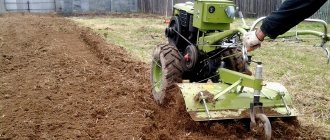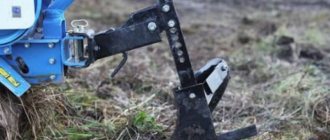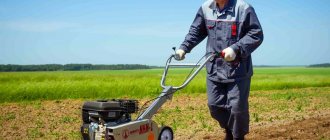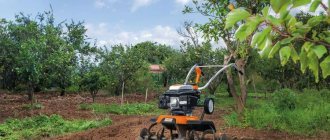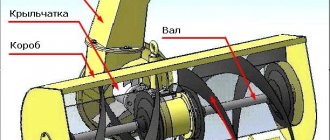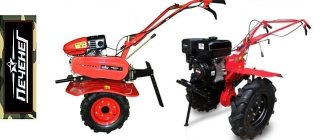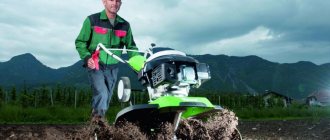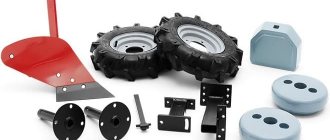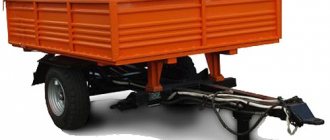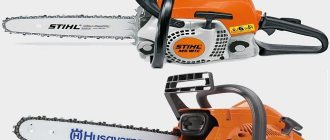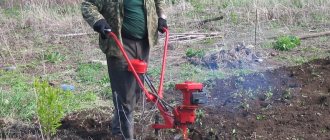A walk-behind tractor is a universal equipment with which you can plow the land, plant root crops, hill up potatoes and harvest. Such dacha equipment today is not particularly expensive, which determines its extraordinary popularity. Most often, walk-behind tractors are used specifically for plowing land for planting potatoes. The technique of loosening soil using a walk-behind tractor is not particularly complicated. However, it is still necessary to know some features of this operation.
Plowing the land with a walk-behind tractor with an adapter
The quality of plowing improves if the plow is turned into a module for transport and arable purposes. The adapter is a kind of trailer. The functionality of a unit with an adapter is comparable to a tractor and its capabilities. Plowing is easy but slow. To plow virgin soil, you need a walk-behind tractor weighing more than 100 kg.
In conclusion, it should be recalled that every year you need to change the direction of plowing. Walk-behind tractors Neva, Khoper, MTZ, Centaur and some other brands can plow landfills, hill up potato crops and perform a whole range of other work on a plot of land and in the yard. For autumn harvesting, a canopy is used that lifts the soil and passes it through the grate. The tubers remain on top.
Did our tips help you? What criteria do you pay attention to first when choosing a walk-behind tractor?
What is the difference between a walk-behind tractor and a walk-behind cultivator?
Ensuring a high level of productivity largely depends on the quality of the work carried out on plowing the land. In previous times, this procedure was extremely labor-intensive and took more than one week. Now the work of business executives has been greatly simplified, since with the help of a walk-behind tractor or a motor-cultivator, you can plow a large area in just a few hours. Working with this technique has its own rules and features.
Plowing a large area with a motor cultivator
Many novice farmers are wondering what is the difference between a walk-behind tractor and a walk-behind cultivator? According to knowledgeable people, there are no fundamental differences between these two agricultural devices. However, some features can be highlighted. A cultivator is a mechanism for cultivating land for subsequent crops, improving the soil structure and ensuring an optimal level of mixing of soil with fertilizers applied to it. In addition to soil cultivation, walk-behind tractors can perform a number of additional tasks such as mowing grass, planting, hilling a vegetable garden, harvesting crops, or clearing an area of dried leaves.
Thus, the walk-behind tractor is characterized by wider functionality compared to a motor-cultivator, and it also has more power, which is important when developing virgin lands, for example. But the weight of the cultivator is much less than that of a walk-behind tractor, and working with this type of equipment is much easier and requires less physical effort. This device also costs much less. Therefore, if we are talking about carrying out exclusively arable work on a relatively small area, then many business owners, choosing between two types of equipment, give preference to a motor cultivator.
2.4 Recommendations
The walk-behind tractor should be selected depending on the size of the plot. They are divided into three types:
- Motor-cultivator or light walk-behind tractor. Weighs up to 50 kg. Power – 3-5 horsepower. Designed for cultivating land up to 6 acres using a cutter or cultivator.
- Medium walk-behind tractor. Weight – up to 100 kg. Power – up to 12 horsepower. Plows a plot of up to 120 acres using a light plow.
- Heavy walk-behind tractor. Power – up to 30 horsepower. With its help you can treat an area of up to 2 hectares. Works with a mounted plow.
The most important job of a gardener in spring or autumn is plowing the garden plot. Many households already have their own walk-behind tractor for these purposes, which makes their work much easier. Beginners may have difficulty using this technique. How to plow with a walk-behind tractor, how to adjust the plow to carefully and correctly plow the garden. The answers to these questions will allow you to carry out the required work efficiently.
How to plow with a walk-behind tractor and plow
Today, land owners often use technology. Plowing with a walk-behind tractor is much easier and faster than digging a garden with a shovel. The walk-behind tractor will plow in an hour and a half the entire area that would take a week to dig with a bayonet shovel. But for this you need to control the mechanism correctly. The unit along with attached implements needs:
- deliver to the place of work;
- replace rubber wheels with ground hooks;
- extended axles will give the mini-tractor additional stability;
- hang and adjust the plow;
- start the engine;
- start plowing.
Proper plowing has advantages over other types of work:
- During this process, fertilizers can be applied;
- the plowed depth remains unchanged throughout the entire area;
- the soil is saturated with oxygen and moisture;
- weed growth slows down;
- productivity doubles;
- time is saved.
Operating a walk-behind tractor is simple: you need to walk next to it and use the handles to adjust the direction of its movement. The weight of the unit must be at least 70 kg. Plowing can be done using the Neva walk-behind tractor and other mechanisms. A lighter unit will not pull the plow.
This type of plowing also has disadvantages:
- Do not plow areas with deep roots;
- the fertile layer gradually fades away and loses quality.
The evenness of plowing can be adjusted by the speed of the mini-tractor.
Petrol walk-behind tractor Pobeda (440 10 7212) 7 hp.
Photo: https://beru.ru
The manufacturer produces high-quality units that undergo thorough inspection and testing. The model is equipped with a 198 cubic centimeter four-stroke engine with increased service life and does not require additional maintenance. The best option for use at any time of the year. Supplied with hardened cutters. Intended for use together with a plow, hiller and potato digger.
Petrol walk-behind tractor Pobeda (440 10 7212) 7 hp.
Advantages:
- compactness
- power
- high-quality plowing
- use with potato digger
Flaws:
- a light weight
- Oil leaks when used for a long time
Attention! This rating is subjective in nature, is not an advertisement and does not serve as a purchase guide. Before purchasing, consultation with a specialist is required. This concludes our review. We hope that we have helped answer the question of which is the best walk-behind tractor to buy for plowing. Good choice!
#2020 #Top 10
Read us first - add the site to your favorite sources.
Add a comment
{"commentics_url":"\/\/express-novosti.ru\/comments\/","page_id":1421196,"enabled_country":false,"enabled_state":false,"state_id":0,"enabled_upload": false,"maximum_upload_amount":3,"maximum_upload_size":5,"maximum_upload_total":5,"securimage":true,"securimage_url":"\/\/express-novosti.ru\/comments\/3rdparty\/securimage\ /securimage_show.php?namespace=cmtx_1421196″,”lang_error_file_num”:”\u041c\u0430\u043a\u0441\u0438\u043c\u0443\u043c %d \u0444\u0430\u0439\u043b\u043e\ u0432\u043c\u043e\ u0436\u0435\u0442 \u0431\u044b\u0442\u044c \u0437\u0430\u0433\u0440\u0443\u0436\u0435\u043d\u043e.","lang_error_file_size":"\u041f\u043e \u0436\u0430\u043b\ u0443\u0439\u0441\u0442\u0430, \u0437\u0430\u0433\u0440\u0443\u0437\u0438\u0442\u0435 \u0444\u0430\u0439\u043b \u0440\u0430\ u0437\u043c\u0435\u0440\u043e \u043c \u043d\u0435 \u0431\u043e\u043b\u0435\u0435 %d MB.","lang_error_file_total":"\u041e\u0431\u0449\u0438\u0439 \u0440\u0430\u0437\u043 c\u0435\u0440\ u0432\u0441\u0435\u0445 \u0444\u0430\u0439\u043b\u043e\u0432 \u0434\u043e\u043b\u0436\u0435\u043d \u0431\u044b\u0442\u044c \ u043d\u0435\u0431\u043e\u043b\ u0435\u0435 %d MB.","lang_error_file_type":"\u041c\u043e\u0436\u043d\u043e \u0437\u0430\u0433\u0440\u0443\u0436\u0430\u0442\u044c \u0442\u0 43e\u043b\u044c ""lang_text_loading":" u0437\u043a\u0430 ..","lang_placeholder_state":"\u0420\u0435\u0433\u0438\u043e\u043d","lang_text_country_first":"\u0421\u043d\u0430\u0447\u0430\u043b\u0430 \u0432\u044b\u04 31\u0435 \u0440\u0438\u0442\u0435 \u0441\u0442\u0440\u0430\u043d\u0443″,”lang_button_submit”:”\u0414\u043e\u0431\u0430\u0432\u0438\u0442\u04 4c","lang_button_preview":" \u041f\u0440\u0435\u0434\u0432\u0430\u0440\u0438\u0442\u0435\u043b\u044c\u043d\u044b\u0439 \u043f\u0440\u043e\u0441\u043c\u 043e\u0442\u0440″,”lang_button_remove ":"\u0423\u0434\u0430\u043b\u0438\u0442\u044c","lang_button_processing":"\u041f\u043e\u0434\u043e\u0436\u0434\u0438\u0442\u0435..."}
How to plow with a walk-behind tractor correctly
The engine is started, you can start plowing. To begin work, the walk-behind tractor is brought to the site. The boundaries of the first furrow are marked with a taut twine. The control knobs should be turned to the left to operate the unit from unplowed ground. The first furrow is made at low speed. This must be done carefully, without losing the orientation cord. Having reached the end of the site, check the plowing depth. It should be within 15-20 cm.
We invite you to familiarize yourself with the Refractometer for winemaking RHW-25DATC | AlfaEco
After this, the right wheel is placed in the furrow, engaged in first gear and continues to plow. The equipment is easy to use and the skill appears quickly. If the plowing depth is not satisfactory, you need to adjust the plow. When plowing, you need to constantly monitor the wheel in the furrow; it should not go beyond its limits.
Sometimes the motor overheats. In this case, it needs to be turned off and cooled. When the soil is plowed, it is filled with oxygen. This affects the future harvest. Autumn plowing is useful. Plow with a walk-behind tractor before winter. In the spring, it remains to dig up some areas in the corners of the garden. For plowing, it is better to use medium and heavy class products.
Hanging and adjusting the plow
The plow is attached to the unit using hitches of various designs. First, the hitch is attached to the walk-behind tractor using a kingpin. The fastening should not be strong, with a horizontal play of 5-6˚. If the connection is made firmly, when plowing the ground, the walk-behind tractor will deviate in different directions due to the uneven impact of the soil on the plow. This makes it difficult to control the unit.
The next step is to attach the plow to the hitch. It's better to do this with an assistant. It is not recommended to tighten the nuts completely so that the plow for the walk-behind tractor is adjusted correctly. This is an important operation. If done incorrectly, plowing with a walk-behind tractor will be of poor quality. To properly adjust the plow, the unit is installed on stands 20-25 cm high. They can be made from bricks or scraps of boards.
Ground hooks are installed on stands and fixed. The walk-behind tractor should not overweight. Set the plow bed to a position in which the heel is parallel to the ground. This can be adjusted using adjusting bolts. Now the stands can be removed and the control handles can be installed at the level of the operator’s belt.
At the last stage, the angle between the ground surface and the end of the plow is adjusted. The adjusting screw is unscrewed until the plow blade rests on the ground. Then its back must be raised 2.5 cm above ground level. If this is not done, it will be impossible to plow with a walk-behind tractor. The plowing depth is equal to the height of the stands when adjusted.
Setting up a walk-behind tractor
Working with a walk-behind tractor begins with setting it up. It depends, first of all, on the area of the plowed area, as well as on the quality of the soil. Some universal rules will help you set up your equipment correctly:
- The recommended diameter of the lugs is 50-60 cm, and the width is 18-20 cm. If the dimensions are smaller than those specified, the equipment will not make it possible to make an even furrow; it will be driven on different sides.
- It is preferable to choose a solid wheel rim so that earth does not accumulate on it.
- The weight of the unit must be less than 70 kg, otherwise it will constantly slip.
- The position of the machine itself when plowing should be such that its entire base is completely in contact with the soil. Otherwise, the plowing depth will either be too great, or, conversely, plowing will not work at all.
- When attaching the plow to the coupling device, the fastening nuts are not fully tightened. This leaves the possibility of further regulation. Using just two pins, you can easily connect the plow to the mounting eyelet.
We invite you to read How to clean a bottle with a narrow neck: 18 ways to clean it at home
Recommended Manufacturers
Today, walk-behind tractors are produced by both domestic and foreign companies. In practice, the former are more affordable and less demanding on fuel quality. But poor-quality assembly and manufacturing of component parts are a common cause of breakdowns and failures.
Manufacturers of walk-behind tractors occupying leading positions in the market: Salyut or Neva (both Russia), Caiman (France), Greenfield (China), Belarus (Belarus), Hyundai (Korea).
Let's briefly look at the best models in the rating of walk-behind tractors:
“Belarus 09N-01” - refers to heavy walk-behind tractors, with a strip width of 70 cm and a digging depth of 20 cm. Four-stroke gasoline engine 9.4 hp. allows you to lift even virgin soil.
Advantages: functionality, the ability to use large attachments. Cons: problems with the clutch and gear shifting. Starting price - from 80,000 rubles.
"Hyundai T 2000E" is a lightweight unit capable of processing an area of up to 25 acres. Model parameters: strip width 55 cm, depth - 25 cm. A distinctive feature is a 2.7 hp electric motor. Approximate price - 20,000 rubles.
"Neva MB-23SD-27F" - characterized by a power of 5.5 l/s, three gears (including reverse). Cultivates the soil to a depth of up to 20 cm, with a grip of 85 cm. Pros: low cost and availability of repairs, developed network of service centers. Average price - 90,000 rubles.
“CAIMAN 330” is a walk-behind tractor equipped with a Japanese Subaru engine (power 9 hp). There are 5 speeds to choose from, 2 of which provide reverse. The processing width reaches 60 cm, depth - 20 cm. Positive aspects - long service life, high-quality assembly. Among the few disadvantages is the high price, starting from 190,000 rubles.
Whatever model of walk-behind tractor you choose, pay close attention to the warranty and the availability of service centers for this equipment in your city.
Plowing with a walk-behind tractor and plow
One of the most common tips from experienced gardeners is to stretch the cord along the furrow. This simple operation will help you navigate and make the furrow line even. How to properly plow with a walk-behind tractor with a plow: the wheel of the walk-behind tractor in the next rows follows the previous lane, which is why the line of the first one is so important. They lead it along the long side of the site.
The main work is carried out only after a test furrow and the elimination of all shortcomings. If you increase the speed a little, this will allow you to dig more evenly, without large clods.
Plowing a walk-behind tractor with a plow
Experienced experts advise novice gardeners to begin their plowing work by stretching the cord along the first row. This simple procedure will make the furrow even.
When plowing other rows, the walk-behind tractor wheel will pass along the finished furrow of the first row. For this reason, all other furrows will be smooth; no additional measures are required.
In order to make plowing the garden convenient, the procedure must be carried out along a long row. This will help eliminate additional effort.
Proper plowing of the land using a walk-behind tractor, setting up and preparing the garden for plowing
https://www.youtube.com/watch?v=LgKJ44lxgac
Using mechanical tools to plow a field greatly simplifies farm work. According to statistics, the yield almost doubles if the field is processed using specialized devices.
The following are the advantages of using motorized plows:
- saving time and getting better results by applying a minimum of effort;
- additional loosening of the soil and subsequent fertilization using one tool;
- uniform cultivation of the land and, as a result, improved structural quality and condition;
- saturation of the soil with moisture and oxygen;
- slowing down the growth of weeds through land cultivation.
Petrol walk-behind tractor COUNTRY 1400 MULTI-SHIFT 13 hp.
Photo: https://beru.ru
An agricultural machine designed to tidy up large areas, including virgin lands. Large wheels provide good maneuverability. Rubberized handles make work more comfortable. The model is equipped with a high power engine. Due to this, additional equipment can be used. For example, plow, trailer, snow blower.
Petrol walk-behind tractor COUNTRY 1400 MULTI-SHIFT 13 hp.
Advantages:
- fast acceleration to maximum speed
- powerful traction
- good grip
- quality materials
- presence of differentials
Flaws:
- noisy work
Reasons for deep cutting cutters
In photo 10 you can see that the walk-behind tractor has stopped moving forward, the cutters have gone very deep into the layer of earth. To put it simply, the walk-behind tractor is buried in the ground! Why might this happen? Below are the main reasons why a walk-behind tractor breaks down, as well as ways to eliminate them.
1. The soil on the site is very moist and clogs the knives; you need to wait until the soil dries.
2. The coulter is deeply buried in the soil; it is necessary to adjust the coulter.
3. Insufficient speed, it is necessary to set the gas regulator to the maximum value and check the speed mode (select a higher gear for the walk-behind tractor).
- 4. The soil in the area is highly compacted, so it is necessary to cultivate the area in two times:
- • Primary tillage with minimal coulter depth.
- • Final tillage is carried out when the coulter is buried to the required depth.
We invite you to familiarize yourself with varieties and types of persimmons
5. The cutters of the walk-behind tractor are installed incorrectly; check that the cutters are installed correctly.
These are the most common reasons why the tillers of a walk-behind tractor go very deep into the ground and the walk-behind tractor stands still.
Typical mistakes when choosing a walk-behind tractor
Many inexperienced farmers, when buying a walk-behind tractor for cultivating the soil on their plot, thoughtlessly focus only on cost and appearance. This approach can lead to breakdown of the agricultural unit or inconvenience during its use. Let's look at the main mistakes when buying a walk-behind tractor, and tips that will help you make the right choice.
- When the future owner of motorized equipment for cultivating the land is not aware of the size of his plot and the types of soil on it. For example, for a summer cottage plot of 6 acres, a light-class walk-behind tractor will be sufficient. Even if there is virgin soil on it, you can hire a tractor for plowing once rather than buy a heavy unit and experience inconvenience when using it in the future on a plot with a small area.
- When the farmer does not know exactly what attachment he will use. It is necessary to think in advance which tools will be needed first, and not try to choose a walk-behind tractor with the maximum number of attachments, which may not be useful later. Read specialized forums or watch video reviews of experienced users to compile a list of attachments, taking into account the manufacturer’s recommendations.
- You should select in advance a walk-behind tractor model from a trusted manufacturer, the build quality of which will not be in doubt. This is where reviews and testimonials about equipment will come to the rescue; you should not rely only on the consultant in the store. If you primarily focus on cost when purchasing, then when using a cheap unit the following disadvantages will appear:
- poor quality of metal and plastic;
- greatly inflated technical characteristics;
- short engine life;
- difficulty in assembling the walk-behind tractor;
- inconvenience and discomfort during operation: increased noise and vibration levels, heavy weight, non-ergonomic handle without the option of turning and adjusting.
- If you buy a new walk-behind tractor in an unofficial store, being fooled by the big difference in price, there is a high risk of not receiving a warranty, service, necessary spare parts and consumables for your garden equipment. Buy a walk-behind tractor only from authorized dealers.
- You also need to decide which family members will use this equipment for cultivating the soil. For example, for older people, a lightweight walk-behind tractor or cultivator with the maximum number of adjustments is suitable, which will provide comfort and reduce the load on the back, arms and legs. If a fragile girl or teenage child has to work on a summer cottage, it is better to give preference to an ultra-light cultivator.
Plowing process
On farming forums there are often opponents of plowing, who believe that deep tillage destroys the fertility of the soil and disrupts the natural processes occurring in it. Plowing is really not always necessary, but on heavy, neglected or virgin lands it is necessary. There are recommendations on how to plow properly with a walk-behind tractor, and if you follow them, the earth will reward you with a rich harvest:
- Carefully adjust the working depth and angle. If the plow does not have height adjustment, you can drill an additional hole in the stand yourself.
- Till the soil once or twice a year (before sowing and/or after harvesting).
- Change the direction of plowing every season to protect the topsoil.
- On light and well-cultivated soils, use cutters and cultivators; on heavy and virgin soils, use a coulter.
Be sure to read: Do-it-yourself plow for a walk-behind tractor
Before work, you should watch a video on how to plow a walk-behind tractor and how to set it up. In general, everything is simple - the equipment is driven to the edge of the field and put into action. First, the operator passes one furrow, at the end he turns 180 degrees and passes the next one.
Walk-behind tractor with plow
Walk-behind tractors are equipped with various equipment for cultivating land. The plow provides deep loosening of the earth with a dump of the layer. Suitable for heavy and poorly cultivated soils. The working part of the plow that directly cuts the ground is called the coulter. The size and shape of the opener vary depending on the density of the soil and the desired depth and width of cultivation.
After plowing, large spears of earth remain. You can break them up using a harrow (disc or tooth). Harrows effectively loosen clods, thereby improving the supply of oxygen and nutrients.
To properly cultivate the soil, you must follow the rules for working with a walk-behind tractor.
With cutters
Milling cutters are equipped with knives and are designed to loosen the soil. Can be used simultaneously with the opener or separately. Installation simultaneously with the coulter allows you to avoid harrowing and saves time - you can plant or sow in such soil immediately. The use of cutters alone without a plow is justified on light and cultivated soils.
With adapter
An adapter for a walk-behind tractor is a module that allows you to operate it while sitting. It is essentially a two- or three-wheeled cart with a frame, seat and foot rests, hand brake and hitch mechanism. Some adapters can accommodate additional attachments. With the adapter, the walk-behind tractor practically turns into a mini-tractor. This device makes work more comfortable and significantly reduces the load on the operator’s back and arms . In addition, this expands the capabilities of the unit. With additional equipment, it will be possible not only to plow a summer cottage with a walk-behind tractor, but also to harvest hay, clear snow and transport goods.
Be sure to read: Technical characteristics of Agros walk-behind tractors
